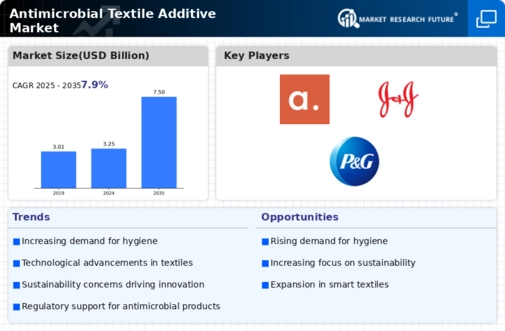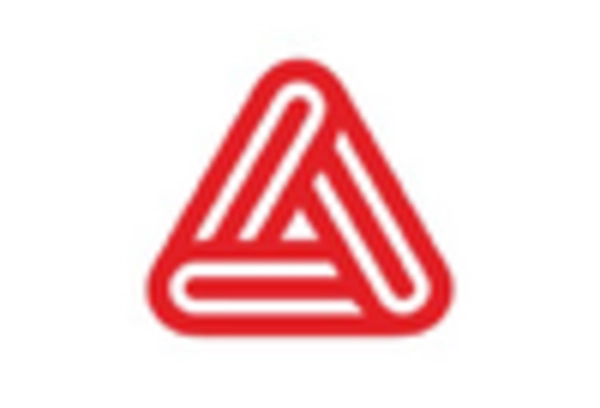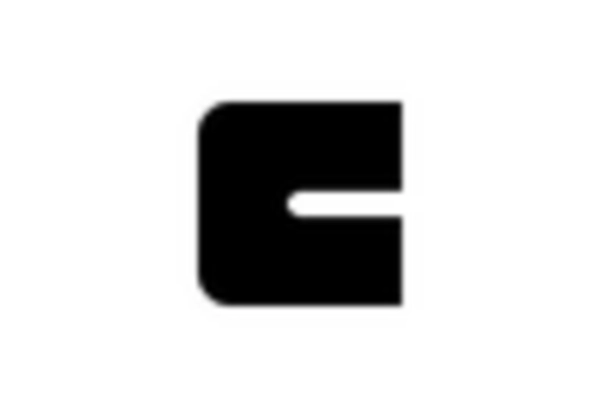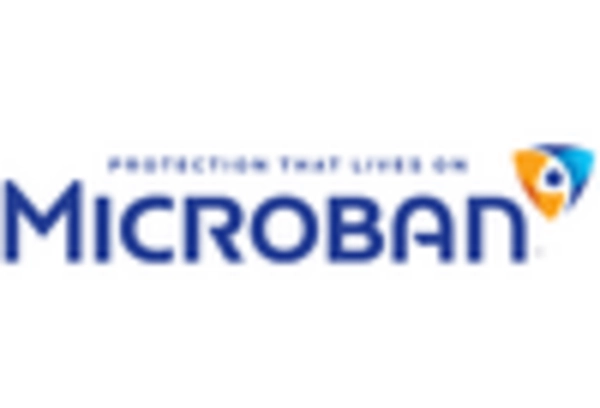-
Executive Summary
-
Market Introduction
-
Market Definition
-
Scope of the Study
-
List of Assumptions
-
Markets Structure
-
Market Research Methodology
-
Research
-
Process
-
Primary Research
-
Secondary Research
-
Market
-
Size Estimation
-
Forecast Model
-
Market Dynamics of Global Antimicrobial
-
Textile Additive Market
-
Introduction
-
Drivers
-
Restraints
-
Opportunities
-
Challenges
-
Trends/Technology
- Raw Material Suppliers
- Manufacturers/Producers
- Distributors/Retailers/Wholesalers/E-Commerce
- End User
-
Market Factor Analysis of Global Antimicrobial Textile Additive Market
-
Supply Chain Analysis
-
Porter’s Five Forces Analysis
- Threat of New Entrants
- Bargaining Power of Buyers
- Bargaining Power of Suppliers
- Threat of Substitutes
- Intensity of Competitive Rivalry
-
Global Antimicrobial Textile Additive Market, by Active Agents
-
Introduction
-
Synthetic Organic Compounds
- Market Estimates & Forecast, 2020−2027
- Market Estimates & Forecast, by Region, 2020−2027
- Quaternary
-
Ammonium Compounds
-
Triclosan
-
Market Estimates & Forecast, by Region, 2020−2027
-
Biguanides (PHMB)
-
N-halamines
-
Poly hexamethylene
-
Market Estimates & Forecast, 2020−2027
-
Market Estimates & Forecast, by Region, 2020−2027
-
Market Estimates & Forecast, 2020−2027
-
Market Estimates & Forecast, by Region, 2020−2027
-
& Forecast, by Region, 2020−2027
-
& Forecast, by Region, 2020−2027
-
Estimates & Forecast, 2020−2027
-
by Region, 2020−2027
-
Forecast, 2020−2027
-
Others
-
Others
-
Market Estimates & Forecast, 2020−2027
-
Market Estimates
-
Metal & Metallic Salts
- Market Estimates & Forecast, 2020−2027
- Market Estimates
- Silver
- Copper
- Zinc
-
Market Estimates & Forecast, by Region, 2020−2027
-
Bio-based
- Market Estimates & Forecast, 2020−2027
- Market Estimates
- Plant Based
- Copper
-
& Forecast, by Region, 2020−2027
-
Market Estimates & Forecast, 2020−2027
-
Forecast, by Region, 2020−2027
-
& Forecast, 2020−2027
-
Region, 2020−2027
-
Global Antimicrobial Textile Additive Market, by
-
Fabric
-
Introduction
-
Cotton
- Market Estimates & Forecast,
- Market Estimates & Forecast, by Region, 2020−2027
-
Polyester
- Market Estimates & Forecast, 2020−2027
-
Market Estimates & Forecast, by Region, 2020−2027
-
Polyamide
- Market Estimates & Forecast, 2020−2027
- Market Estimates
-
& Forecast, by Region, 2020−2027
-
Others
- Market Estimates
- Market Estimates & Forecast, by Region,
-
& Forecast, 2020−2027
-
Global Antimicrobial Textile Additive Market, by Application
-
Introduction
-
Medical Textile
- Market Estimates & Forecast,
- Market Estimates & Forecast, by Region, 2020−2027
-
Apparels
- Market Estimates & Forecast, 2020−2027
-
Market Estimates & Forecast, by Region, 2020−2027
-
Technical Textiles
- Market Estimates & Forecast, 2020−2027
- Market Estimates
-
& Forecast, by Region, 2020−2027
-
Domestic Textiles
- Market Estimates &
-
Market Estimates & Forecast, 2020−2027
-
Forecast, by Region, 2020−2027
-
Global Antimicrobial Textile Additive
-
Market, by Region
-
Introduction
-
North America
- Market
- Market Estimates & Forecast,
- Market Estimates & Forecast, by
- Market Estimates & Forecast, by Application,
- US
-
Estimates & Forecast, 2020−2027
-
by Active Agents, 2020−2027
-
Fabric, 2020−2027
-
Market Estimates & Forecast, by Application, 2020−2027
-
& Forecast, by Active Agents, 2020−2027
-
& Forecast, by Fabric, 2020−2027
-
by Application, 2020−2027
-
Forecast, 2020−2027
-
Agents, 2020−2027
-
Germany
-
Canada
-
Market Estimates & Forecast, 2020−2027
-
Market Estimates
-
Market Estimates
-
Market Estimates & Forecast,
-
Europe
- Market Estimates &
- Market Estimates & Forecast, by Active
- Market Estimates & Forecast, by Fabric, 2020−2027
- Market Estimates & Forecast, by Application, 2020−2027
-
Market Estimates & Forecast, by Active Agents, 2020−2027
-
Market Estimates & Forecast, by Fabric, 2020−2027
-
Estimates & Forecast, by Application, 2020−2027
-
Market Estimates & Forecast, 2020−2027
-
Forecast, by Active Agents, 2020−2027
-
Forecast, by Fabric, 2020−2027
-
by Application, 2020−2027
-
Forecast, 2020−2027
-
Agents, 2020−2027
-
Market
-
France
-
Market Estimates &
-
Market Estimates &
-
Market Estimates & Forecast,
-
Italy
-
Market Estimates &
-
Market Estimates & Forecast, by Active
-
Market Estimates & Forecast, by Fabric,
-
Market Estimates & Forecast, by Application, 2020−2027
-
Spain
-
Market Estimates & Forecast, 2020−2027
-
Market Estimates & Forecast, by Active Agents,2020−2027
-
Estimates & Forecast, by Fabric,2020−2027
-
& Forecast, by Application,2020−2027
-
Estimates & Forecast, 2020−2027
-
by Active Agents,2020−2027
-
Fabric,2020−2027
-
Market
-
Market Estimates
-
UK
-
Market
-
Market Estimates & Forecast,
-
Market Estimates & Forecast, by
-
Market Estimates & Forecast, by Application,2020−2027
-
Russia
-
Market Estimates & Forecast, 2020−2027
-
Market Estimates & Forecast, by Active Agents,2020−2027
-
Market Estimates & Forecast, by Fabric,2020−2027
-
Market Estimates & Forecast, by Application,2020−2027
-
Estimates & Forecast, by Active Agents, 2020−2027
-
Estimates & Forecast, by Fabric, 2020−2027
-
& Forecast, by Application, 2020−2027
-
Market Estimates & Forecast, 2020−2027
-
& Forecast, by Active Agents, 2020−2027
-
& Forecast, by Fabric, 2020−2027
-
Forecast, by Application, 2020−2027
-
Estimates & Forecast, 2020−2027
-
by Active Agents, 2020−2027
-
Fabric, 2020−2027
-
Poland
-
Market Estimates & Forecast, 2020−2027
-
Market
-
Market
-
Market Estimates
-
Rest of Europe
-
Market Estimates
-
Market Estimates
-
Market Estimates &
-
Asia-Pacific
- Market
- Market Estimates & Forecast,
- Market Estimates & Forecast, by
- Market Estimates & Forecast, by Application,
- China
-
Market Estimates & Forecast, by Application, 2020−2027
-
& Forecast, by Active Agents, 2020−2027
-
& Forecast, by Fabric, 2020−2027
-
by Application, 2020−2027
-
Forecast, 2020−2027
-
Agents, 2020−2027
-
Rest of Asia-Pacific
-
India
-
Market Estimates & Forecast, 2020−2027
-
Market Estimates
-
Market Estimates
-
Market Estimates & Forecast,
-
Japan
-
Market Estimates &
-
Market Estimates & Forecast, by Active
-
Market Estimates & Forecast, by Fabric,
-
Market Estimates & Forecast, by Application, 2020−2027
-
Australia & New Zealand
-
Market Estimates & Forecast,
-
Market Estimates & Forecast, by Active Agents,
-
Market Estimates & Forecast, by Fabric, 2020−2027
-
Market Estimates & Forecast, by Application, 2020−2027
-
Market Estimates & Forecast, 2020−2027
-
Market Estimates & Forecast, by Active Agents, 2020−2027
-
Market Estimates & Forecast, by Fabric, 2020−2027
-
Market Estimates & Forecast, by Application, 2020−2027
-
Middle
- Market Estimates & Forecast, 2020−2027
- Market Estimates & Forecast, by Active Agents, 2020−2027
-
East & Africa
-
Market Estimates & Forecast, by Fabric, 2020−2027
-
& Forecast, by Application, 2020−2027
-
Estimates & Forecast, 2020−2027
-
by Active Agents, 2020−2027
-
by Fabric, 2020−2027
-
North Africa
-
Market Estimates
-
GCC
-
Market
-
Market Estimates & Forecast,
-
Market Estimates & Forecast,
-
Market Estimates & Forecast, by Application,
-
Israel
-
Market Estimates & Forecast,
-
Market Estimates & Forecast, by Active Agents,
-
Market Estimates & Forecast, by Fabric, 2020−2027
-
Market Estimates & Forecast, by Application, 2020−2027
-
Market Estimates & Forecast, 2020−2027
-
Market Estimates & Forecast, by Active Agents, 2020−2027
-
Market Estimates & Forecast, by Fabric, 2020−2027
-
Estimates & Forecast, by Application, 2020−2027
-
& Forecast, by Active Agents, 2020−2027
-
& Forecast, by Fabric, 2020−2027
-
by Application, 2020−2027
-
& Forecast, by Active Agents, 2020−2027
-
& Forecast, by Fabric, 2020−2027
-
by Application, 2020−2027
-
& Forecast, 2020−2027
-
Agents, 2020−2027
-
Brazil
-
Market
-
South Africa
-
Market Estimates & Forecast, 2020−2027
-
Market Estimates
-
Market Estimates
-
Market Estimates & Forecast,
-
Rest of Middle East & Africa
-
Market Estimates & Forecast, 2020−2027
-
Market Estimates
-
Market Estimates
-
Market Estimates & Forecast,
-
Latin America
- Market Estimates
- Market Estimates & Forecast, by Active
- Market Estimates & Forecast, by Fabric, 2020−2027
- Market Estimates & Forecast, by Application, 2020−2027
-
Market Estimates & Forecast, by Active Agents, 2020−2027
-
Market Estimates & Forecast, by Fabric, 2020−2027
-
Estimates & Forecast, by Application, 2020−2027
-
& Forecast, by Active Agents, 2020−2027
-
& Forecast, by Fabric, 2020−2027
-
by Application, 2020−2027
-
& Forecast, 2020−2027
-
Active Agents, 2020−2027
-
Fabric, 2020−2027
-
& Forecast, 2020−2027
-
Active Agents, 2020−2027
-
Fabric, 2020−2027
-
Market
-
Argentina
-
Market Estimates & Forecast, 2020−2027
-
Market Estimates
-
Market Estimates
-
Market Estimates & Forecast,
-
Mexico
-
Market Estimates
-
Market Estimates & Forecast, by
-
Market Estimates & Forecast, by
-
Market Estimates & Forecast, by Application,
-
Rest of Latin America
-
Market Estimates
-
Market Estimates & Forecast, by
-
Market Estimates & Forecast, by
-
Market Estimates & Forecast, by Application,
-
Company Landscape
-
Introduction
-
Market
-
Strategy
-
Key Development Analysis (Expansion/Merger & Acquisitions/Joint
-
Venture/New Product Development/Agreement/Investment)
-
Company Profiles
-
BASF SE
- Company Overview
- Financial Updates
- Product/Business Segment Overview
- Strategy
- Key
- SWOT Analysis
-
Developments
-
Sanitized AG
- Company
- Financial Updates
- Product/Business Segment Overview
- Strategy
- Key Developments
- SWOT Analysis
-
Overview
-
Merck KGaA
- Company Overview
- Financial Updates
- Product/Business Segment Overview
- Strategy
- Key
- SWOT Analysis
-
Developments
-
Lonza
- Company Overview
- Financial Updates
- Product/Business Segment Overview
- Key Developments
- SWOT Analysis
-
Strategy
-
Thomson
- Company Overview
- Financial Updates
- Product/Business Segment Overview
- Strategy
- SWOT Analysis
-
Research Associates, Inc.
-
Key Developments
-
Milliken & Company
- Financial Updates
- Product/Business Segment
- Strategy
- Key Developments
- SWOT Analysis
-
Company Overview
-
Overview
-
DuPont
- Company Overview
- Financial Updates
- Strategy
- Key Developments
- SWOT Analysis
-
Product/Business Segment Overview
-
Sarex
- Company Overview
- Product/Business Segment Overview
- Strategy
- Key Developments
- SWOT Analysis
-
Financial Updates
-
Sciessent
- Company Overview
- Financial Updates
- Product/Business
- Strategy
- Key Developments
-
Segment Overview
-
SWOT Analysis
-
BioCote Limited
- Company Overview
- Product/Business Segment Overview
- Key Developments
- SWOT Analysis
-
Financial Updates
-
Strategy
-
Microban
- Company Overview
- Financial Updates
- Strategy
- Key Developments
- SWOT Analysis
-
International
-
Product/Business Segment Overview
-
F Group Nano
- Company Overview
- Financial Updates
- Product/Business Segment Overview
- Strategy
- Key Developments
- SWOT Analysis
-
Conclusion
-
LIST OF TABLES
-
Global Antimicrobial Textile
-
Additive Market: by Region, 2020−2027
-
North America: Antimicrobial
-
Textile Additive Market, by Country, 2020−2027
-
Europe: Antimicrobial
-
Textile Additive Market, by Country, 2020−2027
-
Asia-Pacific:
-
Antimicrobial Textile Additive Market. by Country, 2020−2027
-
Table 5
-
Middle East & Africa: Antimicrobial Textile Additive Market, by Country, 2020−2027
-
Latin America: Antimicrobial Textile Additive Market, by Country, 2020−2027
-
Global Antimicrobial Textile Additive Market Active Agents Market, by
-
Regions, 2020−2027
-
North America: Antimicrobial Textile Additive
-
Market Active Agents Market, by Country, 2020−2027
-
Europe: Antimicrobial
-
Textile Additive Market Active Agents Market, by Country, 2020−2027
-
Table10
-
Asia-Pacific: Antimicrobial Textile Additive Market Active Agents Market, by Country,
-
Table11 Middle East & Africa: Antimicrobial Textile Additive
-
Market Active Agents Market, by Country, 2020−2027
-
Table12 Latin America:
-
Antimicrobial Textile Additive Market Active Agents Market, by Country, 2020−2027
-
Table13 Global Antimicrobial Textile Additive Market Fabric Market, by Regions,
-
Table14 North America: Antimicrobial Textile Additive Market
-
Fabric Market, by Country, 2020−2027
-
Table15 Europe: Antimicrobial Textile
-
Additive Market Fabric Market, by Country, 2020−2027
-
Table16 Asia-Pacific:
-
Antimicrobial Textile Additive Market Fabric Market, by Country, 2020−2027
-
Table17 Middle East & Africa: Antimicrobial Textile Additive Market Fabric
-
Market, by Country, 2020−2027
-
Table18 Latin America: Antimicrobial Textile
-
Additive Market Fabric Market, by Country, 2020−2027
-
Table19 Global Antimicrobial
-
Textile Additive Market Application Market, by Regions, 2020−2027
-
Table20
-
North America: Antimicrobial Textile Additive Market Application Market, by Country,
-
Table21 Europe: Antimicrobial Textile Additive Market Application
-
Market, by Country, 2020−2027
-
Table22 Asia-Pacific: Antimicrobial Textile
-
Additive Market Application Market, by Country, 2020−2027
-
Table23 Middle
-
East & Africa: Antimicrobial Textile Additive Market Application Market, by
-
Country, 2020−2027
-
Table24 Latin America: Antimicrobial Textile Additive
-
Market Application Market, by Country, 2020−2027
-
Table25 Global Active
-
Agents Market, by Region, 2020−2027
-
Table26 Global Fabric Market, by
-
Region, 2020−2027
-
Table27 Global Application Market, by Region, 2020−2027
-
Table28 North America: Antimicrobial Textile Additive Market, by Country, 2020−2027
-
Table29 North America: Antimicrobial Textile Additive Market, by Active Agents,
-
Table30 North America: Antimicrobial Textile Additive Market,
-
by Fabric, 2020−2027
-
Table31 North America: Antimicrobial Textile Additive
-
Market, by Application, 2020−2027
-
Table32 Europe: Antimicrobial Textile
-
Additive Market, by Country, 2020−2027
-
Table33 Europe: Antimicrobial
-
Textile Additive Market, by Active Agents, 2020−2027
-
Table34 Europe:
-
Antimicrobial Textile Additive Market, by Fabric, 2020−2027
-
Table35 Europe:
-
Antimicrobial Textile Additive Market, by Application, 2020−2027
-
Table36
-
Asia-Pacific: Antimicrobial Textile Additive Market, by Country, 2020−2027
-
Table37 Asia-Pacific: Antimicrobial Textile Additive Market, by Active Agents,
-
Table38 Asia-Pacific: Antimicrobial Textile Additive Market,
-
by Fabric, 2020−2027
-
Table39 Asia-Pacific: Antimicrobial Textile Additive
-
Market, by Application, 2020−2027
-
Table40 Middle East & Africa: Antimicrobial
-
Textile Additive Market, by Country, 2020−2027
-
Table41 Middle East &
-
Africa: Antimicrobial Textile Additive Market, by Active Agents, 2020−2027
-
Table42 Middle East & Africa: Antimicrobial Textile Additive Market, by Fabric,
-
Table43 Middle East & Africa: Antimicrobial Textile Additive
-
Market, by Application, 2020−2027
-
Table44 Latin America: Antimicrobial
-
Textile Additive Market, by Country, 2020−2027
-
Table45 Latin America:
-
Antimicrobial Textile Additive Market, by Active Agents, 2020−2027
-
Table46
-
Latin America: Antimicrobial Textile Additive Market, by Fabric, 2020−2027
-
Table47 Latin America: Antimicrobial Textile Additive Market, by Application,
-
LIST OF FIGURES
-
Global Antimicrobial Textile
-
Additive Market Segmentation
-
Forecast Research Methodology
-
FIGURE
-
Five Forces Analysis of Global Antimicrobial Textile Additive Market
-
FIGURE
-
Value Chain of Global Antimicrobial Textile Additive Market
-
Global
-
Antimicrobial Textile Additive Market, 2020−2027, by Country, 2020
-
FIGURE
-
Share of Global Antimicrobial Textile Additive Market, by Country, 2020−2027
-
Global Antimicrobial Textile Additive Market Size, by Active Agents,
-
Share of Global Antimicrobial Textile Additive Market, by Active
-
Agents, 2020−2027
-
Global Antimicrobial Textile Additive Market
-
Size, by Fabric, 2020
-
FIGURE10 Share of Global Antimicrobial Textile Additive
-
Market, by Fabric, 2020−2027
-
FIGURE11 Global Antimicrobial Textile Additive
-
Market Size, by Application, 2020
-
FIGURE12 Share of Global Antimicrobial Textile
-
Additive Market, by Application, 2020−2027

















Leave a Comment